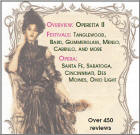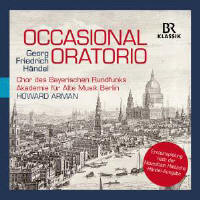Texte paru dans: / Appeared in: |
|
|
Outil de traduction ~ (Très approximatif) |
|
|
Reviewer: John
W. Barker Handel’s Occasional Oratorio is one of the most substantial of the curiosities in his output. The title was apparently Handel’s own, but it is by no means a typical oratorio. It has no plot or characters but is just a big, three-part cantata. It is also a pastiche, combining some new music with a lot transferred from his own works.
The “occasion” of the title
was the crisis of Bonnie Prince Charlie’s invasion of Scotland in 1745 in an
effort to restore Stuart rule to the throne of England. Over the winter of
1745-46, the danger to the Hanoverian succession was acute, and London was
in terror. Handel, in great financial difficulties and barely recovered
from a recent breakdown in his health, rushed to make his contribution to
the cause of George II. For much of the new music he drew on poetry by John
Milton and Edmond Spencer. These texts preach against disobedience,
rebellion, and treason, finally anticipating God’s punishment for the
impious and the joys of (hoped-for) peace. Handel’s haste was demonstrated
not only by the somewhat perfunctory character of the new music but also by
his resort to recycling a great deal of his earlier music, plus a little
snitching of bits from Telemann, Thomas Arne, and Martin Luther. His
self-borrowings in Parts I and II were taken from Deborah, Athalia, and the
Birthday Ode for Queen Anne. Part III opens with a part of the Concerto
Grosso Op. 6:1 and proceeds with a great swatch of numbers from Israel in
Egypt, concluded by the slightly adjusted Coronation Ode, Zadok the Priest.
Credit for helping with the assemblage of this material has been given to
Handel’s early English-language collaborator, Newburgh Hamilton, and this
attribution has been followed in the booklet notes here. But the recent
tendency has been to identify it with the Rev. Thomas Morell, with whom he
was already working on Judas Maccabaeus. That “victory celebration” work was
premiered in April of 1747, safely after the Duke of Cumberland’s crushing
defeat of Charlie and his Jacobites at Cullodon a year before (in April
1746). The Occasional Oratorio actually incorporates an aria that would
later appear in Judas. This was first performed on February 14, 1746, as a London morale-builder at the height of the crises, and there were a few follow-up presentations. It was even revived in March of 1747. In the meantime, it had served its purpose, and Handel thereafter used it as a quarry. But reviving it through recordings is hardly an exercise in Handelian archaeology. The composer actually saw to it that things connect with good musical smoothness. It works quite well as long as you do not expect too much of it. This new recording is not the first, which was made under Robert King (Hyperion 66961: J/A 1995). Using an earlier edition of the score, King was more expansive in his solo team: sopranos Susan Gritton and Lisa Milne, countertenor James Bowman, plus tenor John Mark Ainsley and bass Michael George. Arman’s more limited trio are very good, if lacking the lustre of their predecessors. The Berlin Chorus sings enthusiastically, if their English is not as crystal-clear as King’s forces (including boys). Still, with good engineering help, they make the double-chorus effects work admirably. Arman is an accomplished specialist in Baroque music, able to lead with vigor and style. King’s recording seems hard to find now and deserves revival. Arman’s is a quite satisfactory substitute.
Good booklet notes and full
text with German translation. | |
|
Support us financially by purchasing this disc from eiher one of these
suppliers. Un achat via l'un ou l'autre des fournisseurs proposés contribue à défrayer les coûts d'exploitation |
|
|
|
|
|
Cliquez l'un ou l'autre
bouton pour découvrir bien d'autres critiques de CD |
|




